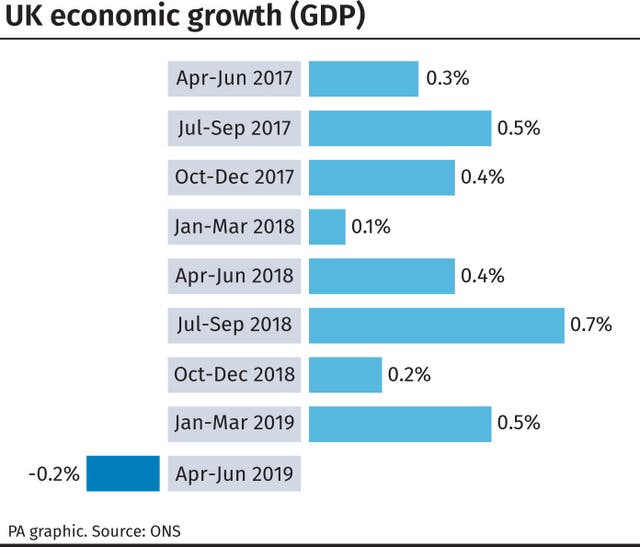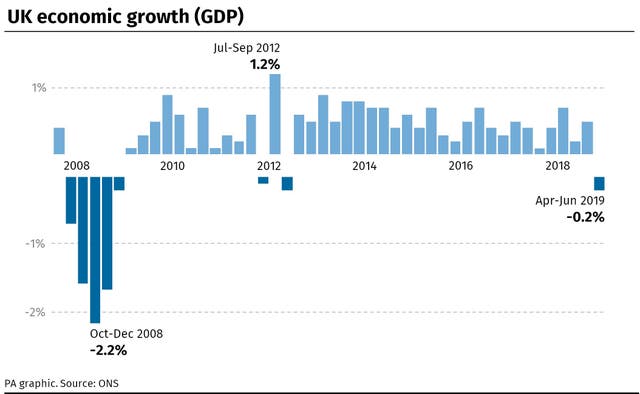
The UK’s economy shrank for the first time since 2012 in the second quarter of this year, as the manufacturing and construction sectors both slumped.
Gross Domestic Product (GDP) decreased by 0.2% between April and June, according to the Office for National Statistics (ONS).
The economy was weaker than both market expectations and the Bank of England’s latest forecasts, which had pointed to flat growth in the quarter.

Rob Kent Smith, head of GDP at the ONS, said: “GDP contracted in the second quarter for the first time since 2012 after robust growth in the first quarter.
“Manufacturing output fell back after a strong start to the year, with production brought forward ahead of the UK’s original departure date from the EU.
“The construction sector also weakened after a buoyant beginning to the year, while the often-dominant service sector delivered virtually no growth at all.”
The contraction compares to 0.5% growth in the previous quarter, when the highest quarterly pickup in manufacturing since the 1980s was recorded.
The ONS said companies had been building up additional goods in the first quarter in anticipation of a March Brexit.
But with the original deadline later called off in favour of an October exit, firms which spent the first three months of the year stockpiling look to have been using up their stores before building up new reserves.

Production output fell by 1.4%, with manufacturing showing a 2.3% decline.
The sector was also weighed down by a drop in transport equipment, which was 5.2% lower due to annual car factory closures being brought forward from summer to April, as companies planned for possible Brexit disruption.
Construction output was also weaker, falling by 1.3%.
This compared with a 1.4% increase in the first quarter, with the quarterly decline largely reflecting a 6% drop in repair and maintenance work.
The services sector, which is usually the main driver of Britain’s economic growth, had its weakest quarter for three years, climbing 0.1%.
In comparison with the same quarter a year ago, GDP was up 1.2%.
In response to the figures, Chancellor Sajid Javid said the fundamentals of the British economy were “strong”.
“The Government is determined to provide certainty to people and businesses on Brexit – that’s why we are clear that the UK is leaving the EU on 31 October,” he said.
See Chancellor @SajidJavid’s response to #GDP figures today 👇 pic.twitter.com/q70hdkeerg
— HM Treasury (@hmtreasury) August 9, 2019
The ONS data dump also showed that the UK’s trade deficit narrowed by £16 billion to £4.3 billion in the quarter, as the level of imported goods declined following sharp rises in the first three months of the year.
Economists said the decline was worse than expected, but not a huge surprise.
Samuel Tombs, chief UK economist at Pantheon Macroeconomics, said it showed that “the underlying economy is sluggish, but it has not stalled”.
Meanwhile, Howard Archer, chief economic adviser to EY Item Club, said the economy should show signs of recovery once Brexit has been finalised.
“On the assumption that the UK does ultimately leave the EU with a ‘deal’ on October 31, we expect an easing of uncertainties to allow economic activity to gradually pick up,” he said.
“Consumer spending should benefit from reasonable fundamentals, although we suspect that real earnings growth in the near term at least may level off while employment growth is expected to be slower.”

Enjoy the convenience of having The Sunday Post delivered as a digital ePaper straight to your smartphone, tablet or computer.
Subscribe for only £5.49 a month and enjoy all the benefits of the printed paper as a digital replica.
Subscribe